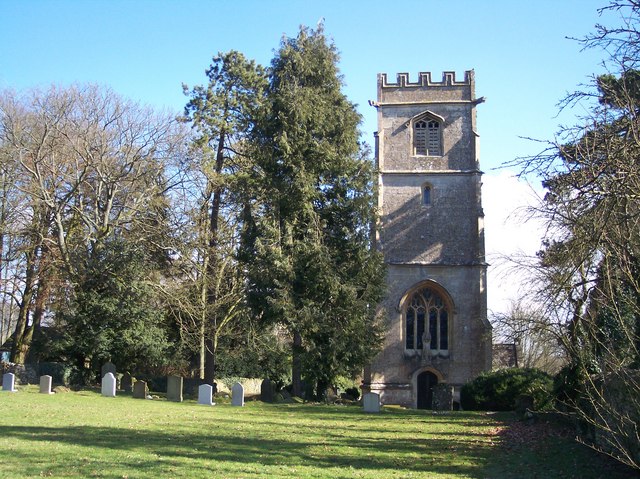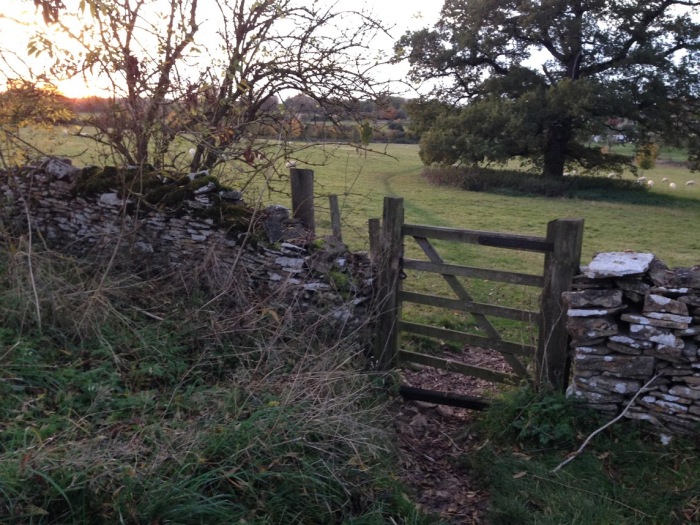
A Cotswold Village
Nestling into the Cotswold hillside, as if sheltering from the bleak winter winds that blow in from the east across the exposed fields, is the little village of Elkstone with its cluster of typical Cotswold stone buildings. At almost 1000 feet above sea level the parish is the highest in Gloucestershire and was mentioned in the Doomsday records. The ancient Norman Parish Church dates from 1160 and is renowned for its unusual dovecote above the chancel and its exquisite Norman arches in the chancel and sanctuary.
I have a strong connection with the village since my grandfather was rector there and my mother grew up in the rectory, going to the village school. Much of her education was gained from the fields and hedgerows of the village. Elkstone is set high on the Cotswold hills a few miles off the Cirencester to Cheltenham road. My Mother used to say how cold it was in winter in a draughty large rectory. I remember her stories about life in the local village school and the characters of the village. Not surprisingly, growing up in Gloucestershire, her favourite Beatrix Potter story was the ‘Tailor of Gloucester’ which she used to love to read to the grandchildren.
Nature’s Classroom
In my mother’s days the country lanes were free of motor traffic and the grass verges were filled with wild flowers. She had a wide knowledge of wild flowers and country matters that lasted all her lifetime. Life was hard in such a remote place, but there was a quality of village life that we so often miss today in our anonymous towns and cities. I’m pleased to see from the village website that there is still a thriving community there.

What treasures await discovery on these roadside banks by observant eyes? We hope no cars will spoil a quiet walk along this delightful left-over from past days. Sadly, there aren’t many of these quiet lanes left now. As we amble, we look for dog violets, an early primrose, unusual ferns, – time for a bit of botanical research when we get home to look up our discoveries in our wildflower reference book.
The following words could well have been written about Elkstone village:
“How lucky country children are in these natural delights that lie ready to their hand! Every season and every plant offers changing joys. As they meander along the lane that leads to our school all kinds of natural toys present themselves for their diversion. The seedpods of stitchwort hang ready for delightful popping between thumb and finger, and later the bladder campion offers a larger, if less crisp, globe to burst. In the autumn, acorns, beechnuts and conkers bedizen their path, with all their manifold possibilities of fun.”
Miss Read – ‘Our Village’
Nature Deficit Disorder
Quite a contrast to the above, many of today’s children are taken by car to the school gates and have probably never had the privilege of walking along car-free country lanes such as we have pictured above, and stopping here and there to pick a flower or look for a bird’s nest or pick up acorns, or beech mast or even perhaps a bird’s egg shell.
Today’s children are seriously deprived of the chance to explore and interact with the open countryside, so vital to practical learning about the environment, conservation and biodiversity.

Hands-on learning.
Progressive schools are more and more using the outdoor ‘classrooms’- the school wildlife and vegetable garden, pond dipping trips, woodland walks, farm trips, fungus forays, all so much better than a stuffy classroom.This is hands-on learning. Watching children involved in such activities is like seeing cattle being let out into the green fields after being shut in all the winter. Like the animals, the young people respond with enthusiasm. Learning becomes easy here, all seem keen to get involved.
But this still leaves a lot of responsibility upon parents to make up for the lack by taking their own children out to explore the open countryside.
.“We have such a brief opportunity to pass on to our children our love for this Earth, and to tell our stories. These are the moments when the world is made whole. In my children’s memories, the adventures we’ve had together in nature will always exist.” ― from ‘Last Child in the Woods: Saving Our Children from Nature-Deficit Disorder.’ by the American, Richard Louv.
For a more recent visit to this Cotswold village see ‘Up on the Cotswolds‘
Your descriptions are beautiful Richard, from that first vision of the village sheltered from the bleak winds, to the recollections of your mother. I’ve always lived in towns, but when I was at school there were so many more fields and lanes to discover – hedgerows and farmlands to explore, fields with horses to get to know. Now, much of it has been built on for houses which is a real shame, but there are still lots of places to find nature even in an urban environment if children are shown how to look for it.
LikeLike
I fully agree, Andrea. Most of the fields I explored as a youth are now the inevitable housing estates. Happily though, wildlife is increasingly coming into our towns and cities. The Peregrine Falcons nesting in the tower of nearby Chichester cathedral are a well known example. You can watch them on their nest with binoculars from the viewing centre. In one part of Worthing, near here, the Swifts nest in the roofs of the old Victorian buildings, darting about between the houses in summer with their screeching calls. Delightful !
LikeLike
I was one of the lucky ones, who spent much of my childhood in a rural village and who delighted in the discoveries of a walk home from the shops or from school: wild campion among the nettles, tiny froglets to catch and admire before releasing them again; soft ‘hedgehogs’ of green moss on old stone walls. Nature at child’s eye-level is so close, so vivid. I looked forward each year to caterpillar time, when I could spot them looping across the underside of leaves; and to the soft fruit season, when I would pick wild blaeberries which stained my fingers purple, or small wild raspberries; and of course to conker season, with squirrels and hedgehogs busy before the winter dearth. My children are blessed in growing up in the heart of Scotland, where our nearest neighbours are sheep and deer, pheasants and ospreys. I have tried to show, to share and to inspire them with my own love of nature. It is a treasury they will carry with them for life.
LikeLike
Lovely comment ! I admire the moving way you write. I have a lot yet to learn. There are a whole series of potential posts waiting in this comment. I look forward to seeing them sometime. We hear the news and the world seems such a depressing place, but when we look at natural things, everything brightens up. William Wordsworth and many other would agree.
Though, as a keen gardener I do struggle a bit with cabbage white caterpillars. The best answer, is to use fine netting, and laugh at watching their unsuccessful antics trying to get through the mesh ! However, I do value the graceful presence of all butterflies in the garden.and wish we could see their return in greater numbers. They adorn the flowers by their colourful presence.
Glad to hear that your own children have such a good foundation.
– Richard
LikeLiked by 1 person
This brought back many memories….I visited Elkstone on a very misty morning years ago and imagined Gran walking to school over the fields!
Interestingly, ‘Forest School’, now taking off in many schools, encourages opportunities to learn outside and develop woodland areas within the school with muddy kitchens, fire pits, bushcraft and outdoor musical instruments! (www.forestschoolassociation.org)
I recently volunteered at our local primary school, helping Year 1 (5-6 year olds) use fire sticks to try and make fire! They were loving it and just so determined to try and get a spark! Forest school is fantastic at building confidence, respect, risk taking in our children.
Grandparents’ knowledge of plants and birdsong is obviously a rich resource …just wondering how this might be shared, enjoyed and passed on to the next generation?
LikeLike
Delighted to have your comment Carol. I’m glad you share my enthusiasm for the subject. It is so good to hear of the growing success of ‘Forest Schools’. Thanks for the link to the website – it looks interesting.These ‘schools’ will have a big influence on those fortunate children who are involved. I see they are also popular in the USA where they are called ‘Nature’s Classroom’. Yes, as parents and grandparents we have an important part to play in all this as well as schools..
-Richard
LikeLike